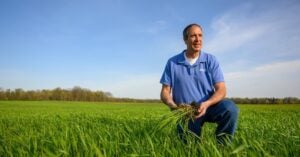A newly released Life Cycle Assessment found the U.S. soybean industry’s global warming potential profile decreased considerably in 2021 for whole soybeans, soybean meal, and soy oil compared to previously reported findings in 2015 and 2010.
Commissioned by the United Soybean Board and the National Oilseed Processors Association, the study assessed the main drivers of the environmental impact, including soybean cultivation and harvesting (e.g., herbicides, field operations, and fertilizer), transportation, and energy usage in processing.
“USB’s mission is to create value for U.S. soybean farmers by investing in research, education, and promotion of U.S. Soy,” says Lucas Lentsch, United Soybean Board CEO. “This body of research helps farmers better assess and understand soy’s contribution to the environmental impacts throughout the life cycle of the entire soybean value chain. Ultimately, this data can competitively position our downstream products such as human foods, animal feeds, biofuels, and other industrial applications.”
As a major commodity crop, soybean production continues to increase over time, contributing $124 billion to the U.S. economy. Global output went from fewer than 50 million tons in 1970 to more than 350 million tons in 2020. The U.S. is one of the commodity’s largest producers and is the second-largest exporter. Soybeans also comprise about 90 percent of U.S. oilseed production in the agricultural sector.

The LCA study by Sustainable Solutions Corporation analyzed soybean cultivation data from 454 farms across 16 states for 2020 and 2021. In addition, it analyzed operations data (for soybean meal, crude soy oil, and refined soy oil) from 52 soybean processors and 27 soy oil refiners across 18 states for 2021.
The study found that the soybean industry’s carbon footprint decreased considerably in 2021 for all U.S. Soy commodities compared to 2015, including a 19 percent decrease for U.S. soybeans, a 6 percent decrease for U.S. soybean meal, a 22% decrease for U.S. crude soy oil and an 8 percent decrease for U.S. refined soy oil (from co-located processing and refineries).
“U.S. soybean processors have committed to efficiencies across plant operations, manufacturing, and transportation processes to improve environmental outcomes amid skyrocketing output,” says Kailee Tkacz Buller, NOPA president and CEO. “The findings of the study align the industry’s improvements with positive environmental outcomes, demonstrating how soy processing has succeeded and allowing us to engage in new ways to maintain that upward trajectory. We look forward to a continued partnership with the soy supply chain to further enhance our commitment to environmental stewardship and lower carbon intensity in our operations.”
Factors contributing to a decrease in global warming potential, include:
- Land Management: Improving soil health and water quality
- Land Efficiency: Advances and improvements in seed quality have contributed to a 24% increase in yields since 2015
- Pesticide Application and Energy Consumption: Changing farming practices, such as decreased chemical application, implementation of no-till, and expanded cover crops
- Manufacturing: Improving technologies and efficiencies at oilseed processing operations, such as switching from coal to natural gas fuel sources
“The results from the LCA conducted for the United Soybean Board and National Oilseed Processors Association demonstrate what can happen when organizations prioritize stewardship and sustainable collaboration,” said Tad Radzinski, president of Sustainable Solutions Corporation. “LCA is a key tool for continuous improvement through identifying and addressing key impact drivers.”

